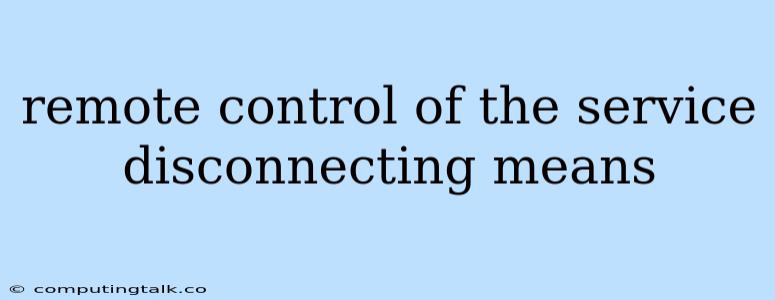Remote Control of the Service Disconnecting Means: Ensuring Safety and Control
Remote control of the service disconnecting means offers a powerful and essential solution for safely and effectively managing electrical systems. This technology allows for the remote control of electrical power, providing a number of advantages over traditional methods.
What is a Service Disconnecting Means?
A service disconnecting means, often referred to as a "service disconnect," is a critical component of any electrical system. It acts as the primary means of isolating the system from the power source, enabling the safe de-energization of equipment for maintenance, repairs, or emergency situations.
Why is Remote Control Important?
Remote control of the service disconnecting means offers significant benefits, particularly in situations where physical access to the disconnect switch is challenging or hazardous. Here are some key advantages:
- Enhanced Safety: Remote control eliminates the need for personnel to physically approach the disconnect switch, reducing the risk of electrical shock or injury. This is especially crucial in hazardous environments, such as high-voltage systems, confined spaces, or areas with flammable materials.
- Increased Efficiency: Remote control allows for quick and convenient operation of the service disconnecting means, minimizing downtime and improving overall operational efficiency.
- Improved Control: Remote control provides the ability to remotely monitor and control electrical power, enabling operators to quickly respond to unexpected events or adjust power levels as needed.
- Enhanced Accessibility: Remote control can be particularly beneficial in situations where the disconnect switch is located in remote or difficult-to-access locations, such as rooftop equipment or underground vaults.
Types of Remote Control Systems
There are various types of remote control systems available for service disconnecting means, each with its own advantages and applications. Here are some common options:
- Wired Remote Control: Wired systems use cables to connect the remote control unit to the disconnect switch. While reliable, they require physical cabling and can be limited by distance.
- Wireless Remote Control: Wireless systems use radio frequency (RF) or other wireless technologies to communicate with the disconnect switch, offering greater flexibility and eliminating the need for cabling.
- PLC-based Control: Programmable logic controllers (PLCs) can be used to automate and monitor the operation of the service disconnecting means, integrating with other control systems and providing advanced functionality.
Choosing the Right Remote Control System
The selection of the appropriate remote control system depends on a number of factors, including:
- Application: The specific requirements of the electrical system and the environment in which it operates.
- Safety Considerations: The level of safety required and the potential hazards involved.
- Budget: The cost of the remote control system and its installation.
- Distance: The distance between the remote control unit and the disconnect switch.
Safety Precautions
While remote control of the service disconnecting means offers significant safety benefits, it's essential to follow proper safety procedures to ensure safe operation. These may include:
- Proper Training: Ensure operators are fully trained on the use and operation of the remote control system.
- Clear Labeling: Clearly label all remote control units and components.
- Regular Inspections: Regularly inspect the remote control system for proper functionality and wear.
- Emergency Procedures: Develop clear emergency procedures for situations where the remote control system fails or malfunctions.
Conclusion
Remote control of the service disconnecting means is a valuable technology that enhances safety, efficiency, and control in electrical systems. By providing the ability to remotely operate and monitor the disconnect switch, this technology minimizes risks, streamlines operations, and allows for rapid response to unexpected events. When selecting and implementing a remote control system, it is crucial to prioritize safety, reliability, and compatibility with existing systems. Careful planning and adherence to proper safety procedures are essential for ensuring safe and effective use of remote control for service disconnecting means.
